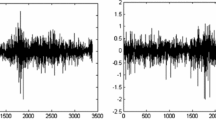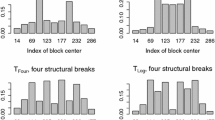Abstract
We consider estimation of stochastic volatility models which are driven by a heavy-tailed innovation distribution. Exploiting the simple structure of the characteristic function of suitably transformed observations we propose an estimator which minimizes a weighted \(L_2\)-type distance between the theoretical characteristic function of these observations and an empirical counterpart. A related goodness-of-fit test is also proposed. Monte-Carlo results are presented. The procedures are also applied to real data from the financial markets.



Similar content being viewed by others
References
Abanto-Valle CA, Bandyopadhyay D, Lachos VH, Enriquez I (2010) Robust Bayesian analysis of heavy-tailed stochastic volatility models using scale mixtures of normal distributions. Comput Stat Data Anal 54:2883–2898
Andersson J (2001) The normal inverse Gaussian stochastic volatility model. J Bus Econ Stat 19:44–54
Asai M, McAleer M, Yu J (2006) Multivariate stochastic volatility models: a review. Econom Rev 25:145–175
Barndorff-Nielsen OE (1977) Exponentially decreasing distributions for the logarithm of particle size. Proc R Soc Lond Ser A 353:401–409
Barndorff-Nielsen OE (1997) Normal inverse Gaussian distributions and stochastic volatility modelling. Scand J Stat 24:1–13
Boscher H, Fronk EV, Pigeot I (2000) Forecasting interest rates volatilities by GARCH(1,1) and stochastic volatility models. Stat Pap 41:409–422
Chib S, Omori Y, Asai M (2009) Multivariate stochastic volatility. In: Andersen TG et al (eds) Handbook of financial time series. Springer, Berlin, pp 365–400
Curto JD, Pinto JC, Tavares GN (2009) Modeling stock markets’ volatility using GARCH models with normal, student’s \(t\) and stable Paretian distributions. Stat Pap 50:311–321
Figueroa-López JE, Lancette SR, Lee K, Mi Y (2012) Estimation of NIG and VG models for high frequency financial data. In: Viens FG et al (eds) Handbook of modeling high-frequency data in Finance. Wiley, New Jersey, pp 3–26
Forsberg L (2002) On the normal inverse gaussian distribution in modeling volatility in the financial markets, PhD Dissertation, Uppsala University
Geske R, Torous W (1991) Skewness, kurtosis, and black-scholes option mispricing. Stat Pap 32:299–309
Giacomini R, Politis DN, White H (2013) A warp-speed method for conducting monte carlo experiments involving bootstrap estimators. Econom Theory 29:567–589
Hansen PR, Huang Z, Shek HH (2012) Realized GARCH: a joint model for returns and realized measures of volatility. J Appl Econom 27:877–906
Harvey AC, Ruiz E, Shephard N (1994) Multivariate stochastic variance models. Rev Econ Stud 61:247–264
Jiménez-Gamero MD (2014) On the empirical characteristic function process of the residuals in GARCH models and applications. Test 23:409–432
Jungbacker B, Koopman SJ (2009) Parameter estimation and practical aspects of modeling stochastic volatility. In: Anderson TG et al (eds) Handbook of financial time series. Springer, Berlin, pp 313–344
Knight JL, Satchell SE, Yu J (2002) Estimation of the stochastic volatility model by the empirical characteristic function method. Austral New Zeal J Stat 44:319–335
Knight JL, Yu J (2002) Empirical characteristic function in time series estimation. Econom Theory 18:691–721
Kotchoni R (2012) Applications of the characteristic function-based continuum GMM in finance. Comput Stat Data Anal 56:3599–3622
Langrock R, MacDonald IL, Zucchini W (2012) Some nonstandard stochastic volatility models and their estimation using structured hidden Markov models. J Empir. Financ 19:147–161
Liesenfeld R, Jung RC (2000) Stochastic volatility models: conditional normality versus heavy-tailed distributions. J Appl Econom 15:137–160
Lin LC, Lee S, Guo M (2013) Goodness-of-fit tests for stochastic volatility models. J Multivar Anal 116:473–498
Meintanis SG, Taufer E (2012) Inference procedures for stable-Paretian stochastic volatility models. Math Comput Model 55:1199–1212
Nagel H, Schöbel R (1999) Volatility and GMM-Monte Carlo studies and empirical estimations. Stat Pap 40:297–321
Ngatchou-Wandji J, Harel M (2013) A Cramér-von Mises test for symmetry of ther error distribution in asymptotically stationary stochastic models. Stat Inferace Stoch Process 16:207–236
Qin R, Tian Z, Jin H (2011) Truncating estimation for the change in stochastic trend with heavy-tailed innovations. Stat Pap 52:203–217
R Core Team (2014) R: A language and environment for statistical computing, Statistical Computing, Vienna, Austria
Renault E (2009) Moment-based estimation of stochastic volatility models. In: Andersen TG et al (eds) Handbook of financial time series. Springer, Berlin, pp 269–311
Scott D, Yang Dong C (2012) VarianceGamma: the variance gamma distribution, R package version 0.3-1
Seneta E (2004) Fitting the variance-gamma model to financial data. Stoch Methods Appl 41:177–187
Stojanović VS, Popović BC, Milovanović GV (2016) The split-SV model. Comput Stat Data Anal 100:560–581
Taufer E, Leonenko N, Bee M (2011) Characteristic function estimation of Orstein–Uhlenbeck-based stochastic volatility models. Comput Stat Data Anal 55:2525–2539
Varadhan R, Gilbert PD (2009) BB: an R package for solving a large system of nonlinear equations and for optimizing a high-dimensional nonlinear objective function. J Stat Softw 32(4):1–26
Wuertz D, Rmetrics core team members (2013) fBasics: Rmetrics—markets and basic statistics, R package version 3010.86
Yu J (2004) Empirical characteristic function estimation and its applications. Econom Theory 18:691–721
Yu J, Meyer R (2006) Multivariate stochastic volatility models: Bayesian estimation and model comparison. Econom Rev 25:361–384
Acknowledgments
The research of Simos Meintanis was partially supported by grant Nr. 11699 of the Special Account for Research Grants (E\(\Lambda \)KE) of the National and Kapodistrian University of Athens.
Author information
Authors and Affiliations
Corresponding author
Additional information
On sabbatical leave from the University of Athens.
Rights and permissions
About this article
Cite this article
Ebner, B., Klar, B. & Meintanis, S.G. Fourier inference for stochastic volatility models with heavy-tailed innovations. Stat Papers 59, 1043–1060 (2018). https://doi.org/10.1007/s00362-016-0803-6
Received:
Revised:
Published:
Issue Date:
DOI: https://doi.org/10.1007/s00362-016-0803-6




